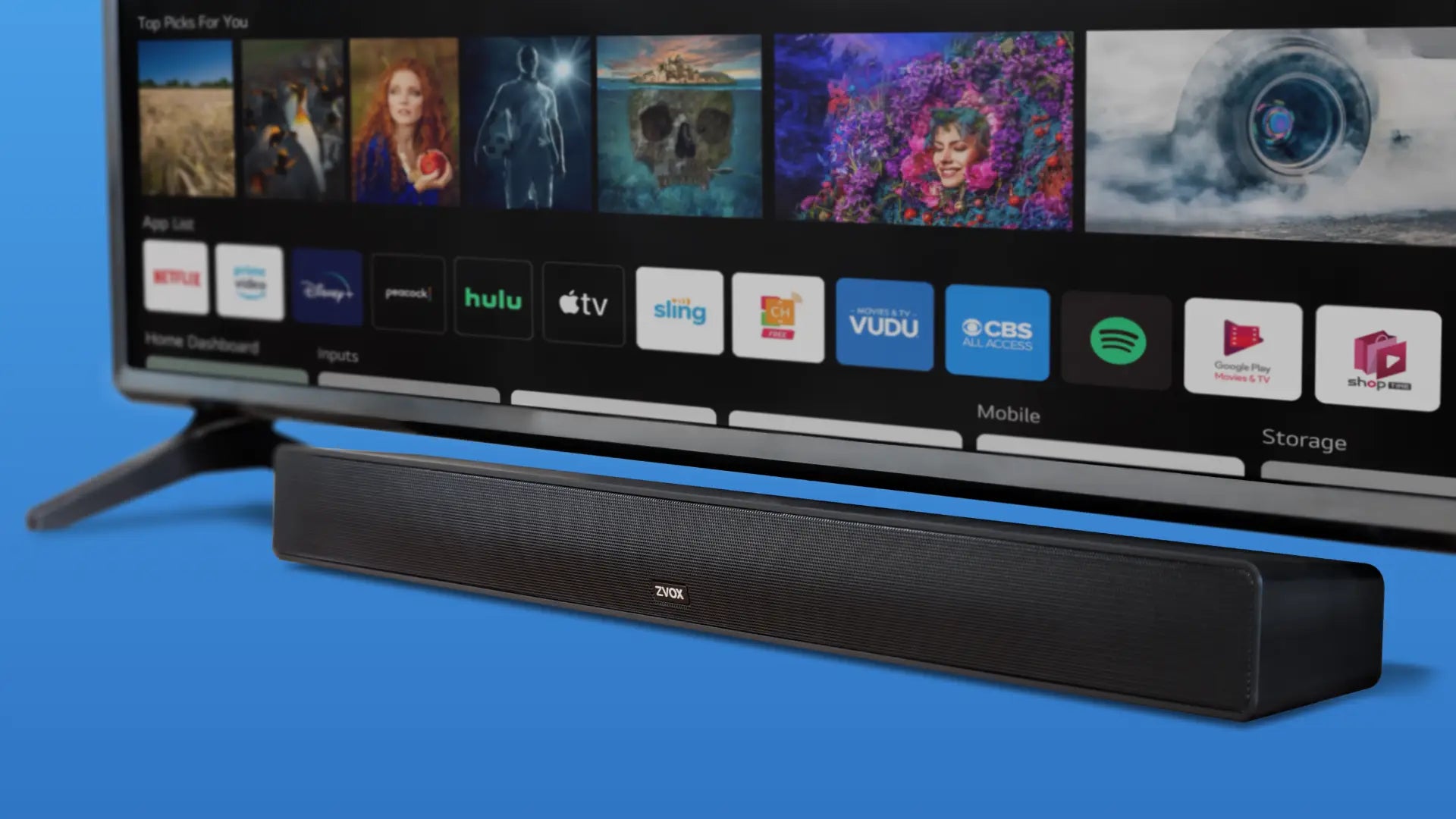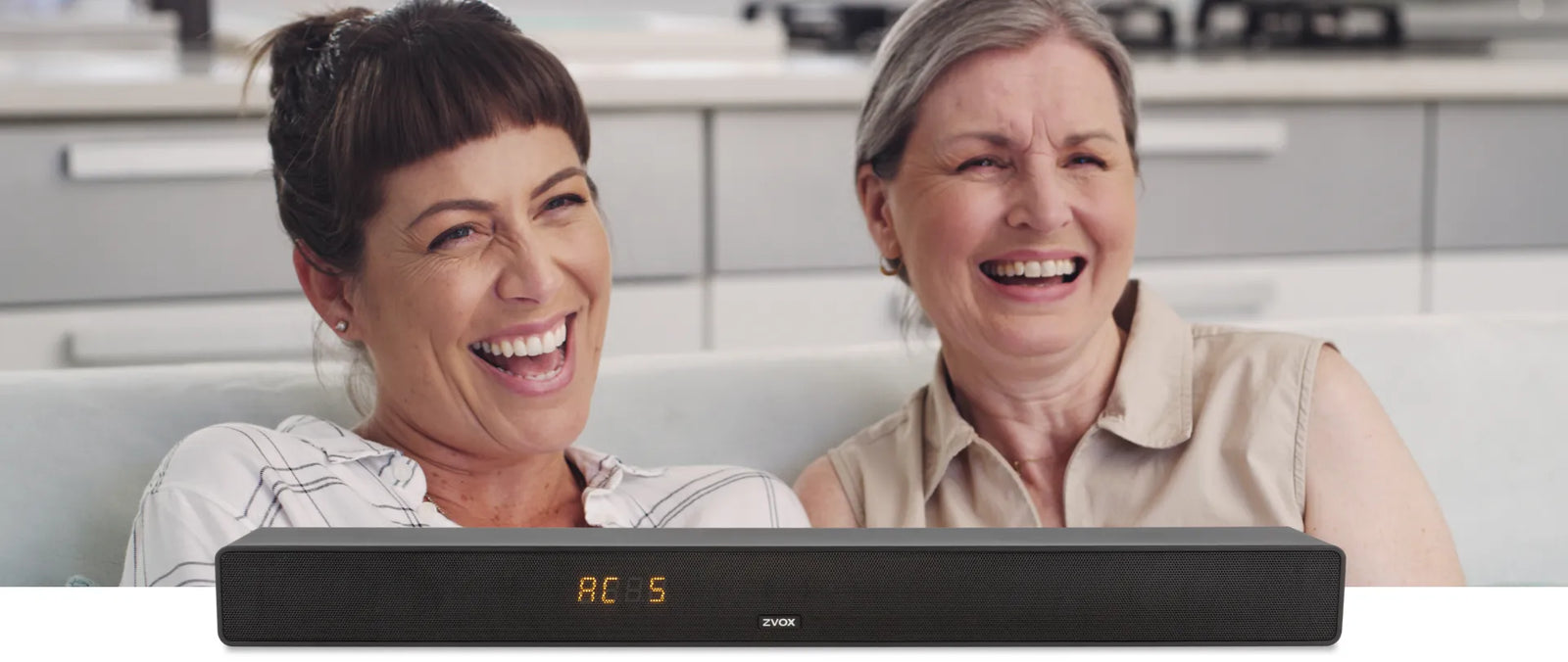You might not know what a dialogue clarifying soundbar is (don’t worry - we’ll tell you!), but you certainly have experienced the problem that this type of soundbar solves.
Have you ever had trouble hearing the dialogue on a TV show because there’s so much else going on in the soundtrack? Background music, sound effects, and other audio in a TV show compete with the dialogue (main character voices) to drown out your ability to understand the words. Following along with the dialogue is crucial to your ability as a viewer to follow the plot of the show. It’s not unlike being in a crowded restaurant trying to listen carefully to your partner across the table. It can be challenging!
Challenges with hearing the dialogue can make for a frustrating viewing experience for both you and your company. Higher frequencies, soft voices, or very dynamic voices can be difficult to hear and understand when watching some TV shows. It may come as a surprise to you that it’s not always your ears that are the problem in those situations.
Modern flat-screen TVs often come equipped with less-than-ideal speakers. It can be challenging to fit full-range, stereo speakers that sound “good” into such a small space. Luckily, a dialogue-clarifying soundbar is an easy and affordable upgrade to the smaller speakers that now come with almost all flat-screen TVs sold today.
While the Hearing Loss Association of America estimates that approximately 48 million people have some degree of hearing loss, most of those people wait seven years before taking any action. Of the adults with hearing loss who are aged 70 and older and could benefit from hearing aids, only 30 percent have ever used them. That fact comes from the National Institute on Deafness and Other Communication Disorders. The good news is that a soundbar can be an effective and simple solution to most TV dialogue comprehension problems.
How do you know the soundbar you’re researching is the right one for your hearing needs and home theater or TV setup?
In this article, you’ll learn about:
-
Dialogue-clarifying soundbars: how they work
- Alternatives to voice-clarifying soundbars
- The best soundbar to boost TV dialogue
- Comparing dialogue-clarifying soundbars
- How to find the right dialogue-clarifying soundbar for you
Dialogue-clarifying soundbars: how they work
A dialogue-clarifying soundbar is a great solution when it comes to enhancing and clarifying the voices you hear on TV. They sound great, but they’re different in key ways compared to other soundbars. Dialogue-clarifying soundbars are specifically built with the goal of enhancing dialogue to make voices on TV more intelligible. They often include several sound-processing modes to adapt to different degrees of severity and types of hearing loss.
The slim soundbar sits in front of, or beneath, your TV. It is usually nearly the same width as your TV and often stands less than three-inches tall in height. A dialogue-clarifying soundbar can be wall-mounted or placed on the TV console in front of your set.
Some models might come with a wireless subwoofer for bass frequencies in the 30 Hz to 250Hz range. Audio’s “low end” - below 80Hz - can be a challenge for smaller speakers to reproduce accurately at a reasonable volume. Having a separate, larger speaker dedicated to those lower frequencies can help a lot, though many soundbars employ physics to make a small enclosure sound much bigger than it is by creating a labyrinth of passages where low frequencies can develop.
Dialogue-clarifying soundbars are built with careful thought to component selection during the research and development phase, but they primarily achieve their benefits through digital signal processing. This audio processing happens nearly instantaneously and it identifies, then treats voice frequencies differently than background noise or music. The processing “pulls” or “lifts” only the voices and amplifies them in isolation to the rest of the TV show’s audio.
If you’ve heard a recent, remastered Beatles album, similar technology was at work for some of the more innovative releases that “unmixed” and then remixed certain albums that were originally mixed down only to mono or stereo. Fully isolated instrument or vocal tracks on the magnetic master tape (the de facto recording medium of the 1960s) did not exist. So, new technology was employed to carefully select the frequencies of each instrument and isolate it within each song. This allowed modern engineers to remix the classic Beatles albums as if they had the original, isolated tracks that would have only existed as the songs were being recorded. In a very similar sense, audio processing technology contained inside the best dialogue-enhancing soundbars can isolate and mix dialogue or voices in tv shows differently than the way it was originally produced and delivered to your television. They do all of this work in real time, which is pretty amazing!
Alternatives to voice-clarifying soundbars
Soundbars might be overlooked if someone wants to build a large and complex home theater system. But those system upgrades come at a price, not to mention the amount of space required to house a receiver, a subwoofer, and at least four other separate speakers. In addition, those systems leave it up to the receiver (or you) to equalize the frequencies for voice clarification. A dialogue-clarifying soundbar often uses special dynamic filtering that isn’t always working at just one frequency or even a few. The best dialogue-clarifying soundbars adapt to the audio program and make dialogue enhancements in real time. Unless you buy the home theater system from a manufacturer that is an expert in dialogue clarification, you’ll be left on your own when solving for TV dialogue enhancement.
Another alternative is a headphone, like TV Ears, that connects to the TV and delivers the audio program directly into your ears. These headphones increase clarity by removing the room from the listening equation, helping to differentiate speech from background noise or reverberation. If you clap your hands in your room and count the time it takes for the sound to completely go away, this is known as the reverberation time. Long reverberation times can muddy TV sound very quickly. Even a small room can cause comb filtering, creating spikes or valleys in the audio response of the television show. This causes certain frequencies or sounds to appear louder or softer than they actually are, sometimes significantly! The wireless headset can be adjusted to your preferred volume and tone, while others listen at a comfortable level. The TV Ears solution, however, only deals with volume, not dialogue enhancement.
As a last resort (and only if everyone in your house is on the same page), the menu on your TV might have dialogue or other audio adjustments. In cases of moderate or severe hearing loss, these “enhancements” can wreck the sound of the show for everyone without hearing loss, so it is not a perfect solution by any means.
The best soundbar to boost TV dialogue
So what’s the best solution? Rated “best bass without a subwoofer” for soundbars in 2021 by CNET, the ZVOX SoundBar is even more affordable than the Sonos Arc. It offers multiple sound mode options, tighter bass, and better sound than most other single-speaker options, as well as Bluetooth connectivity for streaming audio from your phone or tablet. ZVOX’s SoundBar offers great sound quality and a simple setup process.
Comparing dialogue-clarifying soundbars
At the top of the list in terms of affordability and quality, ZVOX, the same manufacturer that makes high-quality, affordable VoiceBud hearing aids, offers an assortment of soundbars that are made with American parts. In addition to the AccuVoice TV speakers, an alternative to TV Ears, ZVOX offers SoundBar home theater systems. These systems include a new aluminum cabinet soundbar that combines “startling performance, great styling, and ease of use” in a variety of sizes, connectivity options, and price, from $299.99 up to $699.99.
At a higher price tag, the Sonos Arc soundbar is aimed at users interested in setting up a multi-room sound system. The cost is upward of $1,000 and while it does offer some voice-enhancing presets, it is not specifically designed for those with hearing loss.
Alternatively, the Vizio V21 soundbar retails for less than $200, but it is not designed for enhancing TV dialogue.
For a soundbar with built-in streaming video, the Roku Streambar is compact and easy to set up for less than $200. However, common complaints include a lack of bass in movies and music, as well as a limited ability to tailor the sound. Again, the Roku Streambar is not designed specifically to enhance TV dialogue, offering only “simple volume modes” that go only part of the way towards solving the problem of dialogue enhancement.
How to find the right dialogue-clarifying soundbar for you
It can be hard to know where to start when trying to make TV dialogue intelligible. We think the ZVOX Soundbars are the best solution at the right price point for most users with hearing loss. Like all other ZVOX products, you get free ground shipping in the continental U.S. and the peace of mind of a 60-day home trial. In addition, free lifetime technical support from a highly-trained, experienced customer support team comes with all ZVOX products. As an alternative, ZVOX also offers factory refurbished and certified soundbars, as well as year-round closeout deals.
Learn more about ZVOX SoundBar and SoundBase home theater systems and more.






